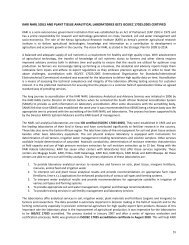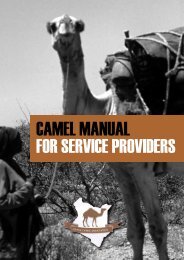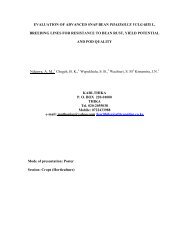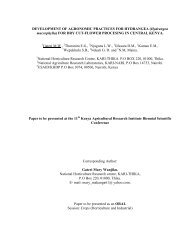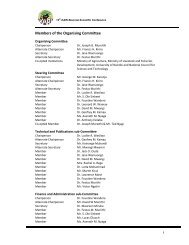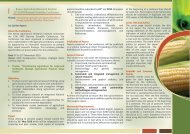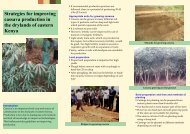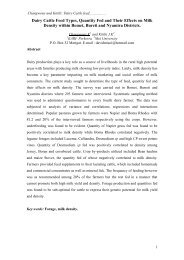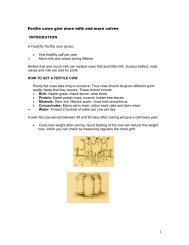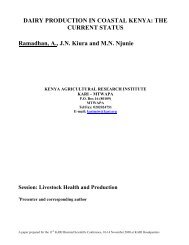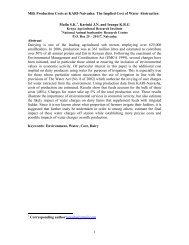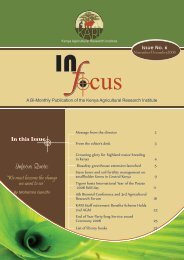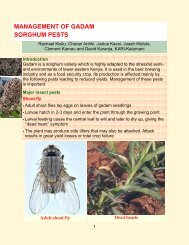1 EFFECT OF DELAYED PLANTING OF SEEDCANE ON ...
1 EFFECT OF DELAYED PLANTING OF SEEDCANE ON ...
1 EFFECT OF DELAYED PLANTING OF SEEDCANE ON ...
Create successful ePaper yourself
Turn your PDF publications into a flip-book with our unique Google optimized e-Paper software.
1<br />
<strong>EFFECT</strong> <strong>OF</strong> <strong>DELAYED</strong> <strong>PLANTING</strong> <strong>OF</strong> <strong>SEEDCANE</strong> <strong>ON</strong> SUGARCANE<br />
GERMINATI<strong>ON</strong>, GROWTH RATE AND YIELD.<br />
G. Omoto, G.O Abayo and J.E Jamoza<br />
Kenya Sugar Research Foundation, P.O Box 44-40100, Kisumu-Kenya.<br />
Email: director@Kesref.org<br />
Omotogeorge@yahoo.com/george.omoto@kesref.org<br />
ABSTRACT<br />
Seedcane quality and quality of planting operations determine the vigour of the crop at the<br />
beginning of the growing cycle. Its health is crucial for successful establishment and eventual<br />
productivity. We established experiments at KESREF, Kibos and Musingu-Kakoyo in West<br />
Kenya in May 2005 to determine the effects of delayed planting of seedcane after stalks<br />
preparation (harvesting) on sugarcane germination, growth and yield. The treatments<br />
consisted of planting heaped sugarcane variety KEN 82-472 seedcane delayed for 0, 3, 6, 9,<br />
12, 15 and 18 days after harvesting. Zero day was the control. The experimental design was a<br />
randomized complete block with three replicates. The plant crop was harvested at the age of<br />
19 months. The results showed that germination percentage resulting from 9-18 days delay<br />
(late) after harvesting seedcane before planting at both sites differed significantly (P< 0.05)<br />
with 0-6 days (early) planted treatments. Similarly tiller density was significantly different<br />
(P< 0.05) between early and late treatments. Moreover there were significant differences in<br />
plant cane yields (tch), plant population and stalk height resulting from seedcane used from<br />
six days after harvesting. However, girth did not differ among the treatments. The results<br />
further showed that the longer the delay in planting prepared seedcane the higher the cane<br />
yields reduction and more the money lost. Therefore seedcane should be planted within six<br />
days after harvesting.<br />
Key words: Delayed planting, seedcane and cane yield loss<br />
1. INTRODUCTI<strong>ON</strong><br />
Seed of any crop is the most important input in agricultural production (Shibale, 2002). In<br />
Kenya seedcane contributes 15-25% of total cost of production of sugarcane (Omoto and<br />
Abayo, 2007). In India the cost accounts for 16-18% of total production (Tamil-Selvan,<br />
2006). The quality of seed (Performance) may not be evident till much later after planting or<br />
even after harvesting. Some farmers are actually aware that delayed planting after seedcane is<br />
cut may have some negative effect on cane germination and consequently result into poor
2<br />
yields. However, since the information given is purely descriptive, and since there is no<br />
systematic observation by farmers, it was not possible to quantitatively correlate delayed<br />
planting of heaped harvested seedcane with crop yield losses. Observation in the Kenya sugar<br />
industry show that harvested seedcane some times take more than two weeks before it is<br />
delivered to farmers by the millers due to lack of transport or some farmers take longer time<br />
to plant supplied seedcane due to delayed seedbed preparation or lack of labour. Singh<br />
(1972) in India found that delay in planting seedcane reduced cane yield significantly.<br />
However, in India seed cane is planted at most five days after harvesting and if it has to stay<br />
longer is covered with trash from harvested seedcane to minimize drying up. In Kenya some<br />
millers and or outgrowers supply farmers with seedcane but little follow up is made to ensure<br />
that seed is planted within the acceptable time. Hence a need to determine quantitative<br />
relationship between delayed planting of harvested seedcane and its corresponding effect on<br />
germination, crop growth and crop yield.<br />
2. OBJECTIVES<br />
• To determine the effect of delayed planting harvested seedcane on sugarcane<br />
germination, growth and cane yield.<br />
• To determine the optimum delay time before planting seedcane.<br />
3. MATERIALS AND METHODS<br />
3.1 Experimental site<br />
One experiment was conducted on KESREF’s research farm in Kibos, Kisumu, Kenya. The<br />
farm is situated between longitude 0 0 24’N and latitude 34 0 48’E at altitude of 1185m above<br />
sea level. The mean long-term maximum monthly temperatures range is 28 0 - 32 0 C while<br />
minimum temperatures range from 14-17 0 C. The mean annual rainfall is 1490mm (KESREF,<br />
2001). Kibos lies in sub- humid region. The soils are mainly Montmorillonitic Vertisols and<br />
Cambisols (KESREF, 2001).The other experiment was planted at Musingu-Kakoyo in West
3<br />
Kenya, Kakamega District, Kenya, situated between longitude 0 0 33’ N and latitude 34 0 50’ E<br />
at altitude of 1620m above sea level. The mean long-term maximum monthly temperatures<br />
range from 20-30 0 C. The mean annual rainfall is 2028 mm and the area is in humid region<br />
(KESREF, 2001). The soils are moderately deep with underlied lateritic murram consisting of<br />
well-drained red clays of low natural fertility.<br />
Table 1: Weather data at planting times at the two sites.<br />
Site<br />
Treatment KESREF, Kibos Musingu- Kakoyo, West Kenya<br />
Planting time interval (days) Mean Temp 0 0 C Rainfall (mm) Mean Temp 0 0 C Rainfall (mm)<br />
0 23.4 5.5 20.4 6.0<br />
3 23.7 8.3 21.6 10.0<br />
6 23.3 Nil 22.4 Nil<br />
9 23.0 Nil 20.8 11.2<br />
12 23.2 Nil 21.2 9.4<br />
15 17.9 8.5 20.5 15.4<br />
18 23.8 3.5 21.5 Nil<br />
Source: KESREF Meteorological section, 2007<br />
3.2 Experimental treatments<br />
The trials were established at Kibos and Musingu-Kakoyo in May 2005 with recently<br />
released sugarcane variety KEN 82-472. KEN 82-472 is medium, maturing sugarcane<br />
variety, harvested at 17-19 months with high sucrose content (Pol of 14%) and high cane<br />
yield (100-120 tch) and is recommended for Western, Nyando, Awendo and Trans Mara<br />
sugar belts of Kenya. The treatments consisted of planting sugarcane variety KEN 82-472<br />
seedcane delayed for 0, 3, 6, 9, 12, 15 and 18 days after harvesting. Zero day or planting<br />
immediately harvested seedcane was the control. The seed cane was harvested and leaves of<br />
the cane stalks stripped off by hand to minimize eye bud damage. It was then heaped at one<br />
place exposed to sunshine. Sugar cane stalks were then taken at staggered time (0-18 days<br />
each at 3 days interval) cut into three eye bud setts then dipped in Confidor® SL 200 solution<br />
at the rate of 200ml/ha to control termite attack on the setts, then laid in 25 cm deep furrows<br />
end-end and covered. In every furrow of 10 m long, 30 setts from clean seedcane of 12<br />
months old were planted. The plots measured 7.2 m wide x 10 m gross. The experimental<br />
design was a randomized complete block with three replicates. The trials were hand-weeded<br />
six times at one month interval. 50kg P 2 O 5 /ha of diamonium phosphate was used at planting
4<br />
at Kibos while 80 kg P 2 O 5 /ha at Musingu-Kakoyo. 100 kg N/ha of Urea was used as topdress<br />
at the age of four months at both sites.<br />
3.3 Data collection and analysis<br />
The data collected included germination percentage at 30 days after planting, tiller count at<br />
3, 5, 7 and 9 months after planting and yield and yield components at harvest at the age of 19<br />
months. Analysis of variance was conducted by a computer using Statistical Analysis System<br />
(SAS) package and means separated from the treatments by least significance level at 5%<br />
significance level. Correlation was done by use of the Spearman correlation.<br />
4. RESULT AND DISCUSSI<strong>ON</strong><br />
4.1 Germination percentage<br />
The results show that germination percentage at both Kibos and Musingu-Kakoyo resulting<br />
from (9-18 days) delay treatment after harvesting seedcane before planting was significantly<br />
(P
4.2 Tiller numbers<br />
5<br />
There were significant differences (P< 0.05) in tiller numbers at both Kibos and Musingu-<br />
Kakoyo among the seven treatments (Figures 1 and 2). The tiller numbers at both sites<br />
increased significantly then reached a maximum at seven months and finally declined in all<br />
treatments. Tiller density is an important yield determinant in sugarcane. The more the tillers<br />
the higher the sugar cane yields. Tiller number was affected by delayed planting. The poor<br />
germination observed in treatments from the 9 th<br />
day delay in planting resulted in the<br />
differences observed. However, some late delayed planted treatments showed higher tiller<br />
numbers because sugarcane has tremendous capacity for tiller compensation.<br />
250<br />
200<br />
150<br />
100<br />
50<br />
0<br />
3<br />
6<br />
9<br />
12<br />
15<br />
18<br />
200<br />
180<br />
160<br />
140<br />
120<br />
100<br />
80<br />
60<br />
40<br />
0<br />
3<br />
6<br />
9<br />
12<br />
15<br />
18<br />
0<br />
3 5 7 9<br />
20<br />
0<br />
3 5 7 9<br />
Time (months)<br />
Time (months)<br />
Fig 1: Changes in tiller numbers over growth period<br />
as affected by delayed planting at Kibos<br />
Fig 2: Changes in tiller numbers over growth period<br />
as affected by delayed planting at Musingu-kako<br />
4.3 Yield components and yield of sugarcane<br />
The cane yield components were stalk height (cm), stalk population, girth (mm) and cane<br />
weight (tch). Table 3 show that cane yield in tch at both Kibos and Musingu-Kakoyo between<br />
late days before planting was significantly (P< 0.05) lower than the early planted cane. The<br />
highest cane yield was observed in plots planted immediately (zero day) at both sites. We<br />
attribute this yield cane differences to original low germination percentage at both sites of<br />
late planted seedcane. Similar result was noticed in millable stalk population too (Table 3).<br />
Treatments that had lower germination percentage showed lower stalk population. Thus cane<br />
yield is positively correlated with stalk number and stalk length in this KEN 82-472 variety.<br />
This is in agreement with Legendre(1970) and Zhou et al (2003). The latter studied the
6<br />
correlation of stalk numbers to cane yield of Co 1148 in Zimbambwe and found that stalk<br />
numbers accounted for 80% of cane yield while the former found that cane yield was<br />
positively associated with stalk number and stalk length. Overall cane yields at Kibos were<br />
significantly greater than cane yields at Musingu-Kakoyo, this was attributed to different<br />
weather sequences at the two sites.<br />
Table 3: Effect of delayed planting of seedcane on sugar cane yield and yield components of KEN 82-472<br />
Delayed planting<br />
time interval (days)<br />
Height (cm) Girth<br />
(mm)<br />
Stalk<br />
pop/ha<br />
TCH Yield loss<br />
(tons)<br />
%<br />
Loss<br />
Loss<br />
(Kshs)<br />
0 221.9 27.7 78,559 89.9 - - -<br />
3 223.1 27.4 75,799 86.2 3.7 4.3 7,955<br />
6 218.7 28.0 72,760 84.9 5.0 5.9 10,915<br />
9 227.9 29.0 70,153 79.4 10.5 13.2 24,420<br />
12 215.9 27.8 69,687 78.3 11.6 14.8 27,380<br />
15 220.7 27.0 70,666 77.5 12.4 16.0 29,600<br />
18 215.0 26.9 71,597 78.2 11.7 15.0 27,750<br />
Mean 220.5 27.7 72,746 82.1 9.2 11.5 21,337<br />
LSD (0.05) 4.7 2.6 1500 5.1<br />
CV% 8.9 5.7 13.8 11.5<br />
Site<br />
Kibos 272.8 28.6 83,346 100.8 11.1 11.0 20,535<br />
Musingu-Kakoyo 167.6 26.8 60,205 60.6 7.2 11.9 13,320<br />
Mean 220.2 27.7 71,776 80.7 9.2 11.5 16,928<br />
LSD (0.05) 108.4 3.2 2400 45.4<br />
CV% 9.0 5.9 14.2 10.6<br />
4.4 Sugar cane yield loss<br />
Sugarcane yield loss (tch) at Musingu-Kakoyo showed that the loss increased gradually from<br />
3 rd to 6 th day delay then increased drastically to 9 th day thereafter increased slowly (Figure 3).<br />
At Kibos the yield loss increased gradually from 3 rd to 6 th day delay then increased gradually<br />
to 15 th day thereafter declined (Figure 3). The correlation for planting time delay and yield<br />
loss was positively correlated. This shows the longer the delay the higher the cane yield<br />
reduction and more the money lost. However, the cane yield loss at Kibos was higher than at<br />
Musingu-Kakoyo (Figure 3). This is attributed to higher rate of evapotranspiration at Kibos<br />
than at Musingu-Kakoyo.
7<br />
18<br />
16<br />
14<br />
Yield loss tch<br />
12<br />
10<br />
8<br />
6<br />
4<br />
2<br />
0<br />
0 3 6 9 12 15 18<br />
Kibos<br />
M.Kakoyo<br />
Delayed planting (days)<br />
Figure 3: Cane yield (tch) loss over change in delayed planting period at Kibos and Musingu-Kakoyo<br />
4.5 Correlation relationship<br />
Spearman correlation coefficients were used to evaluate sugarcane germination percentage<br />
and yield. The Spearman correlation coefficients, for germination percentage and planting<br />
time at Kibos and Musingu-Kakoyo were r = -0.964 and -0.893 respectively, while for cane<br />
yield and planting time at Kibos and Musingu-Kakoyo were r = -0.937 and -0.964<br />
respectively. The correlations at both sites were significant and negative. The negative and<br />
significant correlation coefficients indicate that delayed planting of harvested seedcane is<br />
associated with reduction in cane yield. The longer the delay the higher the cane yield<br />
reduction as shown in (table 3).<br />
5. C<strong>ON</strong>CLUSI<strong>ON</strong> AND RECOMMENDATI<strong>ON</strong><br />
The results showed that delayed planting for 6 days and beyond lowered germination percent<br />
and cane yields of sugarcane variety KEN 82-472 by atleast 10.5% and 13.2% respectively.<br />
This cane yield loss in tch translates to KShs. 24,420 loss. Furthermore, subsequently this<br />
delay negatively affects tiller density, millable stalk population as well as cane height.<br />
Therefore seedcane must be planted within six days of cutting at both sites. Since this study<br />
was only conducted using one cane variety we recommend that several varieties currently in<br />
the industry be tested varying; age of seedcane at harvest, storage of seedcane after<br />
harvesting, specifying soil type and sucrose content be assessed.
ACKNOWLEDGEMENT<br />
8<br />
The authors would like to thank the KESREF, Director for financial and logistic support. Our<br />
sincere gratitude goes to Messer; S. Mutai and G. Jira for data collection and the farmer Mr.<br />
L. Sasaka for providing land.<br />
REFERENCES<br />
Kenya Sugar Research Foundation. (2001). Sugar cane, Grower’s Guide.<br />
Legendry, B.L. (1970). Associations involving yield of sugar per acre and its components in<br />
sugarcane. PhD. Thesis. Louisiana State University, Baton Rouge, La 170 pages.<br />
Tamil-selvan, N. (2006). Sugarcane response to chip bud method of planting. Regional<br />
Research Station, India. ISSCT Agronomy Workshop, Khon Kaeno, Thail land. 23-26 May<br />
2006.<br />
Omoto, G and Abayo, G.O (2007). The effect of seed rate on sugarcane yield in Nyando<br />
zone. Kenya Sugar Research Foundation. Technical Bulletin No. 2 (December 2007)<br />
Singh, P.P . (1972). Annual Progress Research Report, G.BP.V.A. pantnager, India.<br />
Zhou, M.A. Singel, S and Savage, M.J. (2003). Physiological parameters for modeling<br />
differences in canopy development between sugarcane cultivars, Proceedings; SASTA. 77:<br />
610-621.



